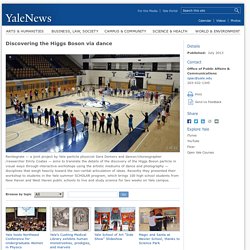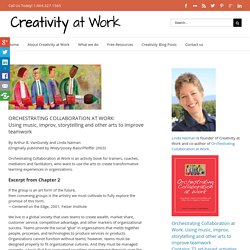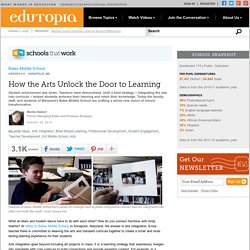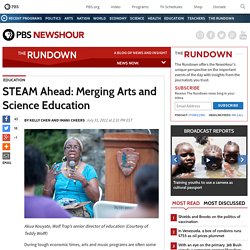

New Interactive Lab Opens to Study Music and the Brain. The Art of Learning Project- Welcome. A Center for Ideas About LearningThe Art of Learning Project is a non-profit educational initiative brought to you by The JW Foundation Imagine if learning was a subject you could study.

By reflecting on your own process, and learning about how your brain works best, you could actually begin to strengthen the muscles that you use every second of every day in order to process and master new information. Do you ever stop to think about… How you learn? Why math may come easily to you but the rules of grammar seem like gibberish? Discovering the Higgs Boson via dance. The first warm-up exercise involves moving randomly among a group of people using existing openings.

It aims to get the group thinking about literal and metaphoric meaning. Participants move at will ... ... while staying within the larger group. Students are asked to simply lean to one side and then the other to test Newton's third law: For every action, there is an equal and opposite reaction. The students learn that, order to shift your center of mass, there must be a net external force. Emily Coates, director of Yale's Dance studies curriculum, explains how force is used to move an object. For example, she notes, by applying force with one's foot against the floor a person can walk. The group members are asked to snap their fingers at one-second intervals, while learning that during each second 40 million possible crossing of proton bunches can happen at the Large Hadron Collider.
Wolf Trap: Arts Education. Dancing Makes You Smarter. For centuries, dance manuals and other writings have lauded the health benefits of dancing, usually as physical exercise.

More recently we've seen research on further health benefits of dancing, such as stress reduction and increased serotonin level, with its sense of well-being. Most recently we've heard of another benefit: Frequent dancing apparently makes us smarter. A major study added to the growing evidence that stimulating one's mind by dancing can ward off Alzheimer's disease and other dementia, much as physical exercise can keep the body fit.
Dancing also increases cognitive acuity at all ages. You may have heard about the New England Journal of Medicine report on the effects of recreational activities on mental acuity in aging. The 21-year study of senior citizens, 75 and older, was led by the Albert Einstein College of Medicine in New York City, funded by the National Institute on Aging, and published in the New England Journal of Medicine. Neuroplasticity. Orchestrating Collaboration at Work: Table of Contents. ORCHESTRATING COLLABORATION AT WORK: Using music, improv, storytelling and other arts to improve teamwork By Arthur B.

VanGundy and Linda Naiman (Originally published by Wiley/Jossey-Bass/Pfeiffer 2003) Orchestrating Collaboration at Work is an activity book for trainers, coaches, mediators and facilitators, who want to use the arts to create transformative learning experiences in organizations. Excerpt from Chapter 2 If the group is an art form of the future, then convening groups is the artistry we must cultivate to fully explore the promise of this form. We live in a global society that uses teams to create wealth, market share, customer service, competitive advantage, and other markers of organizational success.
Organizations need teams to produce creative products, just as artists need the tools of their work. Orchestrating the efforts of team members to collaborate together represents an art form itself. What Do We Mean by “Arts”? Why Use the Arts in Business? Buy now at Amazon 1. 2. Mae Jemison on teaching arts and sciences together. State of the art. Garden Street Academy to Merge Art and Science with New Lego Robotics Program. Aspirants, Apprentices, and Student Engineers. How the Arts Unlock the Door to Learning. Students at Bates Middle School learn about art concepts such as photo composition (above) that are integrated into other curricula like math.

What do Mars and modern dance have to do with each other? How do you connect fractions with Andy Warhol? At Wiley H. Bates Middle School, in Annapolis, Maryland, the answer is arts integration. Every teacher there is committed to weaving the arts and standard curricula together to create a richer and more lasting learning experience for their students. Arts integration goes beyond including art projects in class; it is a teaching strategy that seamlessly merges arts standards with core curricula to build connections and provide engaging context. (See more arts-integrated lesson plans from Bates.) What we also saw in these classrooms were students who were enthusiastically participating in the learning process, and having fun.
A Whole-School Reform. Arts Education and Instrumental Outcomes: An Introduction to Research, Methods and Indicators.pdf. STEAM Ahead: Merging Arts and Science Education. Akua Kouyate, Wolf Trap’s senior director of education (Courtesy of Teddy Wolff) During tough economic times, arts and music programs are often some of the first programs cut in schools.

But at Wolf Trap’s Institute for Early Learning Through the Arts , investing in arts education has been a priority for the past 31 years. A study by the National Endowment for the Arts shows that students from lower socio-economic backgrounds who actively participated in the arts tended to score better in science and writing, and were more likely to aspire to college. The study used survey data gathered over 20 years that followed socially and economically disadvantaged students, from kindergarten into their early twenties. Music and Language, Intertwined.